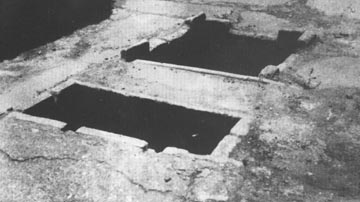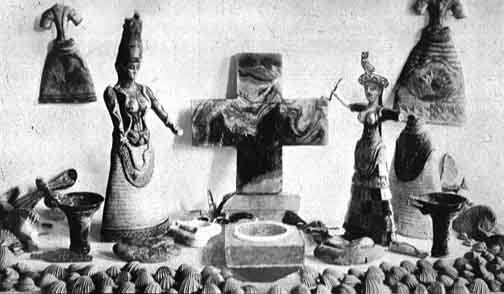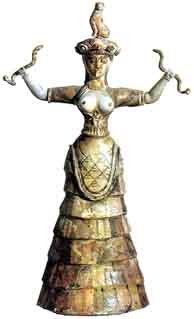Women in the Aegean
Minoan Snake Goddess
Christopher L. C. E. Witcombe
3. The Temple Repositories
Evans began excavations on the Kafala Hill, the site of the "palace" at Knossos, on 23 March 1900. During the next few months, he unearthed about two acres of the site, uncovering rooms along the west side of what later came to be known as the Central Court.
An early discovery, made on 30 March, was a hoard of clay tablets inscribed in Linear B script in the Room of the Chariot Tables. The most dramatic discovery, though, was the Throne Room complex, excavation photographs of which were used to illustrate a brochure issued by The Cretan Exploration Fund appealing for donations of money to support Evans' work.
Also uncovered during this first season was the area between the Throne Room and the Room of the Chariot Tables which included the Room of the Tall Pithos and a small room with two open, and empty, cists or vats in its floor. At the time of their discovery, the cists were of little interest.
Three years later, in 1903, it was noticed that the pavement around the cists was sagging and upon investigation, two much larger stone-lined cists, or repositories, were discovered beneath the floor.

image source: Brown, 1983
|
The two cists in 1900
In 1900, in the floor of a small room next to the Room of the Tall Pithos, were found two open (and empty) cists or vats. The upper borders of each were cut so that lids could be fitted and secured. They were evidently used for storage.
|

image source: Brown, 1983
|
The two earlier cists discovered in 1903
In 1903, it was noticed that the floor in the room was sinking. Beneath the paving were discovered two stone-lined cists or repositories. It was possible to leave one of the later cists in position as it lay directly above the partition between the two earlier cists.
|
In the upper part of both were a large quantity of vases. Below the layer of vases was found a variety of small objects including a clay tablet and three disks inscribed with Linear Script A, a hoard of 150 clay seal impressions, ivory and bone objects, bronze clamps and handles (of wooden chests), crystal petals and disks, gold leaf, Libation Tables carved from steatite, heaps of painted sea-shells, a marble cross, and a number of faïence objects.
The faïence objects (faïence is a pottery glaze technique using ground quartz which can be tinted) included fragments of three figurines, subsequently identified as a "snake goddess" and votaries, as well as votive robes and girdles, cups and vases, shells in the round, quantities of beads, a variety of plaques for inlay, and two small reliefs, one of a cow suckling a calf and another of a wild goat (or agrimi) suckling a kid. Evans believed that most of the objects formed part of a cult shrine which he tentatively reconstructed.

Snake Goddess Shrine, as reconstructed by Evans
Most of the faïence pieces were found in the Eastern Repository. However, part of one of the figurines was found in the Western Repository, which indicated to Evans that the contents of the Eastern depository had been considerably disturbed at some period, probably by plunderers at the time of the destruction of the "palace" by an earthquake around 1600 BCE. Evans' implies that the faïence objects were broken at this time and most of the fragments swept into the Eastern Repository when the palace was rebuilt. Though the figurines must have been in existence before then, they are usually dated to the time of their destruction, around 1600 BCE.
4. EVANS'S "SNAKE GODDESS"
|

Minoan Snake Goddess
from Knossos, Crete
c. 1600 BCE
faïence
height 131/2 inches (34.3 cm)
(Archeological Museum, Herakleion)
Copyright © (text only) 2000
Christopher L. C. E. Witcombe
All rights reserved
|

